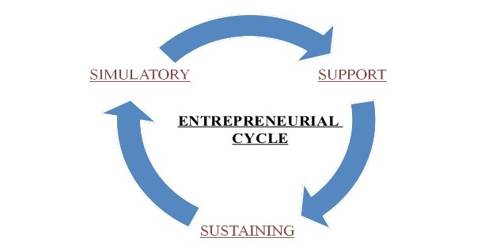The entrepreneurial development cycle is the combination of all support activities and assistance that are conducted and provided continuously for the development of entrepreneurship. It generates entrepreneurial awareness in the community through well-planned publicity. It is a process of evolving one’s skills in a systematic manner.
There are three elements of an entrepreneurial development cycle. These are discussed below:
(1) Stimulating assistance: There are some activities and assistance that are performed to encourage potential entrepreneurs to take initiative. These are called stimulating assistance. Some examples of stimulating assistances are given below:
- Entrepreneurial education;
- Planned publicity for entrepreneurial opportunities;
- Identification of potential entrepreneurs through scientific methods;
- Motivational training;
- Help and guidance in selecting products and preparing project reports;
- Making available techno-economic information;
- Entrepreneurial counseling.
(2) Supportive assistance: There are some helping activities and assistance that make the potential entrepreneurs enable to conduct their operations. These are called supportive assistance. Some examples of supportive assistance are given below:
- Arranging finance;
- Providing land, power, water etc.
- Guidance for selecting and obtaining machinery;
- Supply of scarce raw materials;
- Help in getting licenses;
- Providing common facilities;
- Granting tax relief and other subsidies;
- Help marketing product.
(3) Sustaining assistance: There is some assistance that is provided to the existing entrepreneur to continue their enterprise successfully. These are called sustaining assistance. Some examples of sustaining assistance are given below:
- Help modernization;
- Help in diversification;
- Policy change;
- Creating a new opportunity for marketing;
- Need-based common facilities centers.















